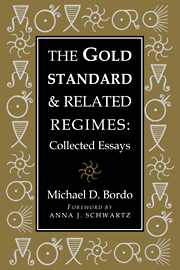Book contents
- Frontmatter
- Contents
- Foreword
- 1 The Gold Standard and Related Regimes: Introduction to the Collection
- Part I History of Doctrine and the Gold Standard
- Part II The Gold Standard as a Commodity Standard
- Part III The Gold Standard as a Contingent Rule
- Part IV Historical Case Studies
- Part V The Bretton Woods International Monetary System
- 12 The Bretton Woods International Monetary System: A Historical Overview
- 13 Is There a Good Case for a New Bretton Woods International Monetary System?
- Index
- Titles in the series
12 - The Bretton Woods International Monetary System: A Historical Overview
Published online by Cambridge University Press: 19 October 2009
- Frontmatter
- Contents
- Foreword
- 1 The Gold Standard and Related Regimes: Introduction to the Collection
- Part I History of Doctrine and the Gold Standard
- Part II The Gold Standard as a Commodity Standard
- Part III The Gold Standard as a Contingent Rule
- Part IV Historical Case Studies
- Part V The Bretton Woods International Monetary System
- 12 The Bretton Woods International Monetary System: A Historical Overview
- 13 Is There a Good Case for a New Bretton Woods International Monetary System?
- Index
- Titles in the series
Summary
After twenty years of floating exchange rates, there is now considerable interest, among those concerned over its perceived shortcomings, in an eventual return by the world to a fixed exchange rate regime. This interest has been enhanced by the apparent success of the European Monetary System (EMS) and the prospects for European monetary unification. The Bretton Woods system was the world's most recent experiment with a fixed exchange rate regime. Although it was originally designed as an adjustable peg, it evolved in its heyday into a de facto fixed exchange rate regime. That regime ended with the closing by President Richard Nixon of the gold window on 15 August 1971. Twenty years after that momentous decision, a retrospective look at the performance of the Bretton Woods system is timely.
This chapter presents an overview of the Bretton Woods experience. I analyze the system's performance relative to earlier international monetary regimes – as well as to the subsequent one – and also its origins, operation, problems, and demise. In the survey, I discuss issues deemed important during the life of Bretton Woods and some that speak to the concerns of the present. The survey is limited to the industrial countries – the G-10 and especially the G-7.1 do not examine the role of the International Monetary Fund (IMF), the fundamental organization of Bretton Woods, in the economies and international economic relations of the developing nations.
- Type
- Chapter
- Information
- The Gold Standard and Related RegimesCollected Essays, pp. 395 - 500Publisher: Cambridge University PressPrint publication year: 1999

